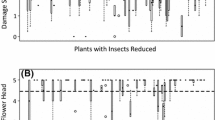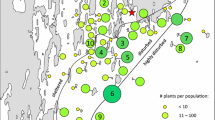Abstract
Plant fitness is strongly affected by flowering phenology, and there are several ecological factors that are thought to shape the distribution of flowering times. One relatively underexamined factor is the timing and intensity of attack by herbivores that feed on flowers or developing seeds. This study tests the hypothesis that herbivores that feed on developing seeds of wild sunflower, Helianthus annuus (Asteraceae), impose selection on flowering phenology. First, the study population was found to contain genetic variation for mean date of flowering, so this trait could evolve if natural selection were operating. Next, the phenological pattern of abundance of five seed-feeding herbivores was documented. Damage by three herbivores, Haplorhynchites aeneus (Cucurlionidae), the head-clipping weevil, Homoeosoma electellum (Lepidoptera: Pyralidae), the sunflower moth, and Suleima helianthana (Lepidoptera: Tortricidae), the sunflower bud moth, was highest early in the flowering season, and declined as the season progressed. Damage by one herbivore, the seed fly Gymnocarena diffusa (Diptera: Tephrididae), was lowest early in the flowering season and increased as the season progressed. Finally, damage by two seed weevils, Smicronyx fulvus and S. sordidus (Curculionidae), whose damage was not distinguished, was constant through the flowering period. Third, damage by Haplorhynchites, Homoeosoma, and Suleima was found to be detrimental to plant fitness, suggesting that plants that flower when these herbivores are not abundant should have higher fitness. Finally, two phenotypic selection analyses were performed. The first included damage by Homoeosoma and Suleima, as well as flowering date, leaf area, and inflorescence diameter, as characters predicting plant fitness. In this analysis directional selection was found to act to decrease damage by the two herbivores, but did not act on flowering date. The second selection analysis was identical except that damage by the two herbivores was not included. In this analysis significant directional selection was found to favor later-flowering plants. Comparison of these two analyses suggests that all selection on flowering phenology is attributable to damage by Homoeosoma and Suleima: plants that flower later avoid damage by these two herbivores. While other influences on flowering phenology, such as pollination, mate availability, and seasonality, have been well documented, this study is one of few to demonstrate natural selection on flowering phenology that is a direct consequence of insect attack.
Similar content being viewed by others

Author information
Authors and Affiliations
Additional information
Received: 17 November 1998 / Accepted: 18 July 1999
Rights and permissions
About this article
Cite this article
Pilson, D. Herbivory and natural selection on flowering phenology in wild sunflower, Helianthus annuus . Oecologia 122, 72–82 (2000). https://doi.org/10.1007/PL00008838
Issue Date:
DOI: https://doi.org/10.1007/PL00008838



